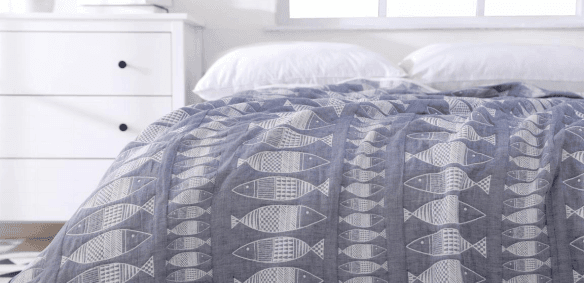How to pick the right blanket for your bed

When nighttime temperatures take a tumble, reach for a blanket to add an extra layer of cozy warmth to your bed. Blankets tend to go unseen and unsung – it’s your comforter or duvet that takes top billing as the star of the bed, and your sheets that provide the caress of softness your skin craves, but it’s the blanket, tucked in between the two, that creates an extra pocket of air to keep you warm.
When it comes to buying a blanket, you might think there’s nothing to it – just choose the color you like in the right size for your mattress. Although choosing the right blanket is fairly straightforward, there’s a little more to it than that.

Choose the Right Size
If you’re buying a blanket for your bed, you need one large enough to cover the mattress with a few extra inches to tuck in around the sides and bottom. Though exact sizes vary from manufacturer to manufacturer, typical blanket sizes (length by width) are:
Twin: 90” x 65”
Full/Queen: 90” x 85”
Queen: 90” x 90”
King: 90” x 110”

Choose the Right Fabric
Here’s where it gets a bit trickier. There are quite a few common blanket fabrics – each has benefits, so choose the one that best suits your needs.
Cotton: Cotton blankets hold up well to repeated washing, making them a good choice for those who suffer from allergies. Depending on the weave, cotton can be lightweight enough for use as a summer blanket, or heavy enough for winter warmth.
There are even organic cotton blankets for those who prefer a green lifestyle.
Wool: Wool is heavy, warm, and provides excellent insulation while allowing moisture to evaporate. It’s a great choice if you want a very heavy, warm blanket, but some people are allergic or sensitive to wool.
Down: Similar to a down comforter, but thinner and lighter, down blankets have a layer of feathery down or a synthetic substitute sandwiched between layers of fabric.
These blankets are lightweight but very warm. If you are allergic to feathers, be sure to select a synthetic substitute.
Cashmere: Luxurious and soft, cashmere blankets are warm and silky, but they are also very expensive.
Synthetics: There are many synthetic fabrics used for blankets: acrylic, polyester and microfiber are common ones. Synthetic blankets are warm, but often attract a good deal of static electricity, and tend to hold onto hair, dust and loose threads. Inexpensive synthetics are also subject to pilling and wear. On the plus side, these blankets are generally inexpensive.
Fleece: Cozy, extra warm, and yet not too heavy, fleece and microfleece blankets are especially popular with children. Fleece is good at wicking away moisture — another benefit when used on a child’s bed.
Vellux: Sometimes referred to as “hotel blankets,” Vellux blankets contain a thin foam core surrounded by soft nylon plush with a velvety texture. These blankets are hypoallergenic, stand up to repeated washings even at high temperatures, and are warm and very soft. A great choice for anyone with allergies.

What About Weave?
Along with different fabrics, blankets have different weaves that provide varying levels of warmth and weight.
Thermal: Generally found in cotton blankets, a thermal weave is loose, letting air circulate easily. These lightweight blankets are good for the summer months.
Knit: Cozy knit blankets are heavy and warm. You’ll usually find these made from wool or synthetic materials.
Quilted: Down blankets are typically quilted to keep the down or down substitute from shifting inside the blanket.
Conventional: The typical blanket weave is very tight and close, creating excellent insulation for body heat.

Newsletter
Subscribe to the Balix Newsletter now.
Product Categories
Get in touch
- hebe@bailixin.com
- +86 186 3025 3808
- North Side Of Xiaoyi River, Logistic Industrial Zone, Hongrun Street, Gaoyang County, Baoding, Hebei, China (Mainland)
© 2024 Balix. All rights reserved.






